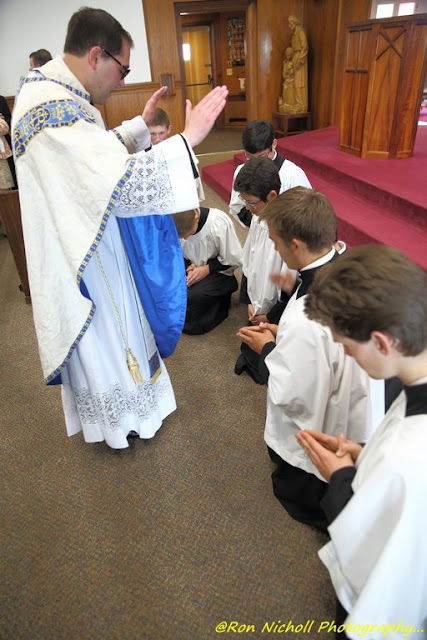Shewn adjacent is a vignette from a larger painting titled
Scenes from the Life of Saint Augustine. It was painted in Bruges around 1490 by the artist who is referred to as
The Master of Saint Augustine. This painting is housed now in the marvellous setting of
The Cloisters, from whose website I was able to obtain this enlarged view.
Saint Augustine is shewn here being ordained a priest. What Augustine, the bishop and the lesser ministers are wearing is typical of the style of vestments found throughout the Low Countries (what we would now identify as the Netherlands and Belgium) in the 15th century. Let us examine that in detail.
All four are wearing well-gathered albs, which are decorated with rectangles of damask (called apparels) along the lower edge on the front and the back and also on the cuffs. Note also, how closely-fitting the sleeves of the albs are, and that the apparels of the ministers match the violet colour of the priest's chasuble. Apparelled albs and apparelled amices like this were worn all over Europe (including in Rome) throughout the mediaeval period.
An exceedingly slender maniple and stole is worn by Augustine (a form typical of England and Northern Europe) which are made from the same fabric as the apparels of his alb and amice.
Both the chasubles are decorated with the Y shape of orphrey. Although this form of decoration was centuries old when this work was painted, it was more commonly found in some places and less in others. It was not as common in Germany and southern Europe.
The ornament of the Augustine's chasuble appears to be tabernacle-like work of saints, embroidered on a dark background. This contrasts beautifully with the lighter violet colour of the chasuble. In
another post, shewing Mass being offered in Siena Cathedral, we find the a very similar colour scheme of chasuble and ornament. The colour is blue-ish and not too dark. Note how much more penitential and striking in character these sombre orphreys are compared with the all-too-common use of gold on purple or violet vestments (a decorative scheme which displays a real lack of imagination).
Both chasubles are semi-conical in form, or perhaps more precisely a modified version of the semi-conical shape. Were Augustine and the bishop pictured to have their arms by their sides instead of raised, the chasubles they are wearing would fall just about to their wrists. This is a more abbreviated width from earlier centuries. The curving folds from the bottom of the chasuble were produced when the shoulders of the vestments were very steeply sloped: quite unlike the poncho-like form of the modern chasuble and the sandwich-boards effect of the fiddleback chasuble.
The bishop is shewn in Pontificals. Beneath his chasuble of scarlet-red is seen an ornamented golden dalmatic. The tunic cannot be seen. He is wearing a precious mitre; the horizontal and vertical ornamental bands are worked onto a base of gold fabric and enriched with precious stones.
Lastly, a word on the colours of the vestments. The more modern concept of matching colours did not exist in the mediaeval period, when the whole scheme of the Liturgical Colours (as we know them now) was far less developed. A practical reason for this "mix and match" was the lack of available fabric in matching colours. But that does not fully account for the more familiar approach we see in paintings and illuminations of the mediaeval period, where a chasuble was made up from one fabric, but the stole, maniple and apparels were made up from another, and usually contrasting, fabric. What a varied and pleasing effect this produces!
Thanks to Brother Stephen O. Cist for helping to clarify the scene depicted in this vignette.
Click on the image for an enlarged view.















